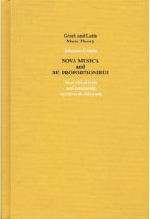Nova Musica and De Proportionibus
Last updated: 17.12.19

| Printed: | 1993 | Author: | Johannes Ciconia |
| Publisher: | University of Nebraska Press | ISBN: | 0803214650 |
| Suppliers: | 






|
Greek and Latin Music Theory, Vol 9
Hardcover - 531 pages (November 1993) , usually ships within 2-3 days.
Amazon Review
Johannes Ciconia (ca. 1370-412) is well known today as a composer both of sacred and secular music, but his theoretical works, probably written in Padua during the first decade of the fifteenth century, have until now been available only in manuscript form. This is the first complete edition of both of Ciconia's theoretical works: the Nova musica, with its attendant De tribus generibus melorum, and the shorter De proportionibus, itself a revision of the third book of the Nova musica.
The Nova musica is unique as the only only large-scale speculative work of the period known to have been written by an accomplished composer. The purpose of the work, clearly stated by Ciconia in the prologue, is to return to the writings of earlier authors (through the eleventh century) and, with their material as a basis, to redefine the scope of the discipline of music so that is may be classified and may function as one of the literary arts, in addition to its usual standing as a mathematical discipline.
The first three books consist largely of quotations from earlier authors, covering the topics of consonance (intervals and the scale), species (modes), and proportions. Much of this material parallels large sections of the famous Lucidarium of Marchetto of Padua.
In the fourth and final book, Ciconia demonstrated how, by means of the material already presented, chants can be classified and declined or parsed according to the principles of grammar. This new view of music can be regarded as a clear indication of the new humanistic approach to the arts. Two plates and more than one hundred figures illustrate the edition. The plates provide representative and contrasting examples of the handwriting and format of the illustrations in two of the principal sources.

